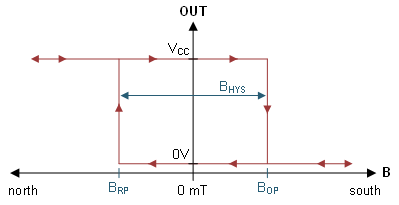SBAU410 October 2022 TMAG5115
3.1 Quick Start Setup
- Power up the EVM using a variable power supply:
- Set the power supply voltage to the desired setting between 3 V and 12 V. Do not turn on the power yet.
- Connect the power supply V- terminal to the black GND wire connected to the EVM.
- Connect the power supply V+ terminal to the red VCC wire connected to the EVM.
- Turn on the power supply
- At power up, the device default state is high and the LEDs stay in the off state. Place the handheld D3X8 magnet over one of the three TMAG5115 devices found on the EVM. Depending on the polarity of the magnet, you may see the LED turn on or remain in the off state.
- Rotate the magnet to the opposite orientation. If the threshold is met, the device should have the opposing reaction than it did in the previous step. A South field over the BOP will turn on the LED while a North field less than the BRP threshold will turn off the LED. See Figure 3-1 for the magnetic response of a Hall-effect latch.
 Figure 3-1 Hall Latch Output.
Figure 3-1 Hall Latch Output.